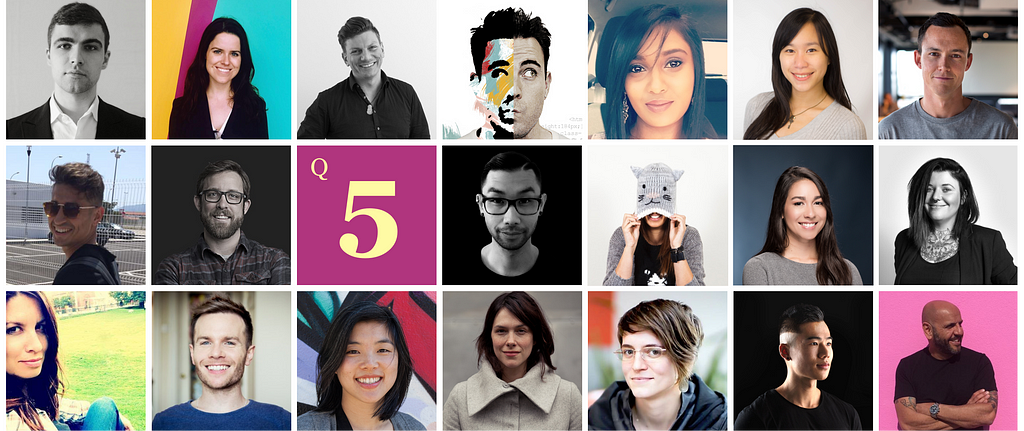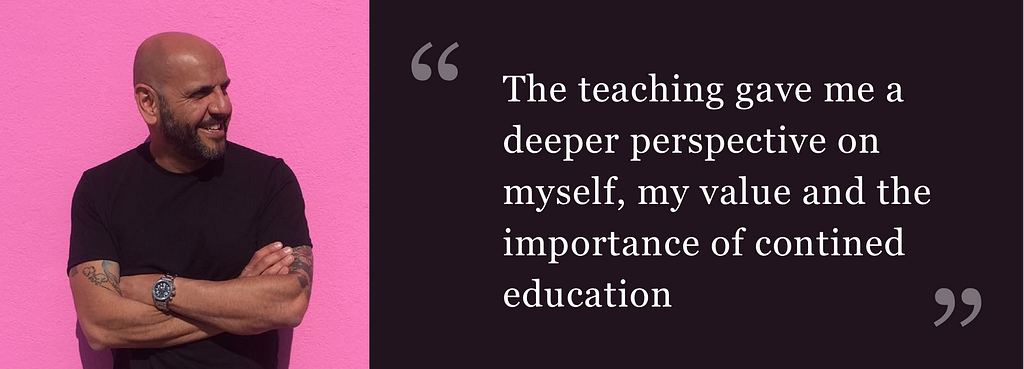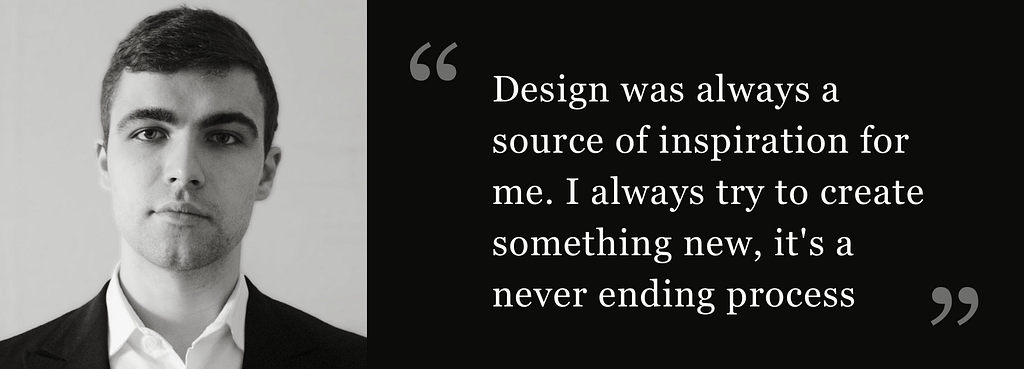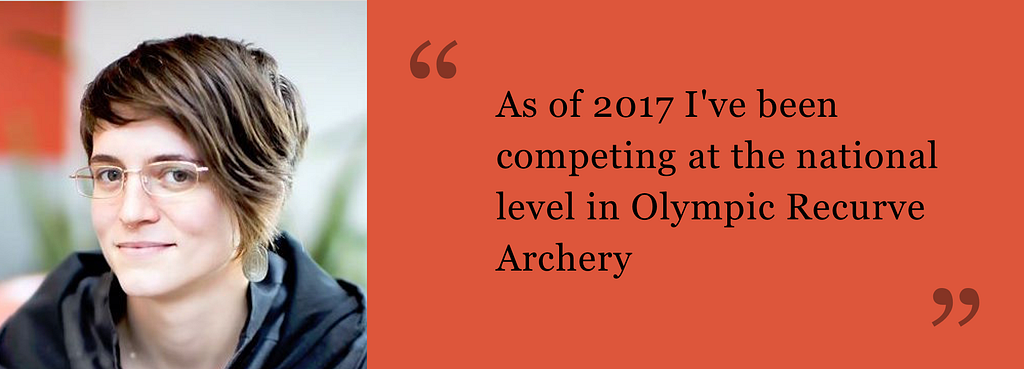Build Design Systems With Penpot Components
Penpot's new component system for building scalable design systems, emphasizing designer-developer collaboration.

UX Planet — Medium | Guy Ligertwood

Learn From twenty experienced designers as we go deep into one question every week.
Intro Article: Get to know the designers
Question 1: How did you get into design?
Question 2: How your typical work day?
Question 3:What things you wish you knew when you started in design?
Question 4: What are the best ways for you to stay inspired?
Question 5: (you’re here) What do you want to see in my UX design portfolio?
“Good UX designers need to be like water. We have to get into every crack and every crevice and find every terminus” (Andrew Doherty)
“Don’t bullshit — be yourself. People lean towards authenticity” (Charbel Zeaiter)

Australian 🇦🇺
I want to see up to three of your BEST projects that are most relevant to the role that you’re applying for.
Specifically, I want to see:
– You possess human-centred design chops to do the job. I want to see that you’re strong in interaction and visual design.
– You can clearly frame the problem you were trying to solve.
– You can set the context, challenges and your role in a compelling narrative.
– You can structure and articulate key design direction and decisions.
– Your process as well as the quality of your solutions.
– Your ability to reflect on what you learned and how you grew.
– Your success in driving an outcome.
– What makes you, you.
I don’t want to see:
– Other people’s work that you ripped off or claimed credit for.
– Trash talking.
– Incomprehensible perspective mockups.
– You’re 55% proficient in logo design.
simonpan.com or on twitter

American 🇺🇸
I’m not sure I’ve any authority on this question. I’ve graduated to that level of designer whose portfolio just has a few lines of quirky text (“weird horse girl who became a product designer”).
I’ve had that line in my portfolio for years as a bit of a joke, which became a little more than that. It’s certainly embarrassing, but it starts a story about how I think and how I might fit on a team, which is really what a portfolio should do.
When I’m looking for those answers in the work, I tend to care less about what candidates have designed so much as why. What was the people problem?
How did you know it was a problem? What did success look like, and what principles led you there? When were you wrong, and how did you fix it?
For me, humility, honesty, and heart go a long way in that story.
On Twitter

Formerly Product Design Manager at Google, Mountain View
Australian 🇦🇺
I look for proof that you truly understand the core of the UX problems you’ve tried to solve. I don’t just mean “What’s the prettiest way to make this easier to use?”, but do you REALLY understand the ins-and-outs of the entire situation?
Good UX designers need to be like water. We have to get into every crack and every crevice and find every terminus.
There should be nothing that we haven’t touched or seen or been exposed to.
There should be ‘no one’ on a project that knows more than you about the problem that you have tried to solve.
My website or on Medium

South African 🇿🇦
I would like to see the candidate’s process laid out in the portfolio.
I don’t mind if its one project, but it must be as detailed as possible. It must contain everything from the problem statement right down to the usability test report.
I want to see the candidates thought process and how they arrived at their conclusions. I would also like to see a bit of creativity in the portfolio.
I have personally done one of these, and it works great in an interview process.
It’s easier to talk through the process with a potential employer if you have done the hard work, put in the effort, and you know your process back to front.
My Linkedin

Australian 🇦🇺
If I’m going to hire a tiler to tile my bathroom, I want to see real examples of other bathrooms they’ve tiled. I want to know their process, and I’d also like to hear from previous clients they’ve worked with.
Like a tiler, a UX designer is a service provider with specific skills to perform a particular task.
When I’m hiring a designer to work within my team, I want to see examples of previous work they’ve done and also get an idea of their thought process.
Project case studies are a great way of detailing your previous work. Some designers only display the finished visual designs in their portfolio with no context around how they produced the designs.
I think it’s important to include the following in a design case study:
– The problem that you’re solving
– Initial research findings
– Sketches or wireframes of early concepts
– User testing insights
– The visual designs
– Finally how your solution performed once it was launched.

American 🇺🇸
3 or more solid projects:
What about work under NDA?
You’ll have to find something else to show. I’ve learned the hard way that “Trust me, the work I can’t show is excellent” doesn’t cut it. If you don’t have other work, find some.
But keep in mind, spec work and “unsolicited redesigns” get a bad rep. Instead, seek out an organisation in need of great design (social good hackathons, nonprofits, etc.) and work on a project with real users, real constraints.
Coding
If you can code your portfolio, awesome. Comment your code so people who inspect it can see your fingerprints there. If not, keep the layout simple (plenty of designers use Squarespace), and focus on your project work.
An appeal: please don’t say “Hi there.”
How many successful websites use their most valuable real estate for a cutesy intro? “Hi, we’re Amazon.” “Hey there, welcome to CNN!” Your portfolio is a sales pitch for you. Know what you’re about, and lead strong with that.
hugg.in or I’m @bhuggins on Twitter and Instagram

Australian 🇦🇺
A good fit for my team means meeting business needs, the future pipeline of work and complementary skills and attitude.
I look for people who display self-awareness and an understanding that the business of design demands more than a beautiful folio and/or a list of awards. They must be confident in the value they offer and be able to sell that story.
Folios are a useful storytelling tool, especially for specific specialist design roles like illustrators, visual designers, UI designers, motion designers.
However, as design evolves through emerging disciplines, design thinking, collaboration and co-design, it has become increasingly difficult to judge someone’s suitability based on a folio.
We are working in a time where casts of thousands are required on projects that don’t seem to end, where multiple hand-offs are the norm and quite often, great innovation never sees the light of day. So it’s important to hear the story of the role someone played in a specific context, their tasks and their approach, rather than judging visual or tangible outcomes alone.
As a rule, I ask designers to complete a time-boxed, hypothetical design task. There are arguments for, and against this method, however, my personal view is that it’s a great way to get to know more about the person, see how they think, their process and how they apply their specialist skills in context.
1. Do your homework: Know your mark — stalk the shit out of whoever you are meeting, the company and ask for a job description/brief.
2. Know your value: If someone is paying you to do a job, they will want to know what value you are going to add. Come prepared to make your case.
3. Make it relevant: If you’ve done your homework, you’ll know which work is right to show contextually.
4. Tell your story: This is your chance to shine and talk about yourself. Be the real you!
5. Don’t waste time: Whoever interviews you will be a busy person, so be organised and don’t show too many examples — tailor a small contextual sample that gets to the point quickly. And don’t waste your time either — qualify the opportunity as much as you can.
My Linkedin

Australian 🇦🇺
If you’re new to UX, it’s normal to replicate and show common processes, however, spend some time and interweave a story about your journey and how you came to move into UX.
Our recently finished fulltime UX students in Sydney were nothing short of breathtaking; they worked in group projects and individual ones. When they had their final showcase, there were seven of them with seven entirely different takes on the UX process and seven vastly different portfolios.
Don’t ever discount your previous experience. UX is about problem-solving for humans in a digital context. We’ve all had to solve problems and use a mix of an analytical mind with creative inspiration to solve these problems.
You’d need to show at least 3 or 4 commercially relevant projects to get any interest. By commercially relevant, this means real work. While it’s nice to have a pet project or a creative idea, anyone who wants to hire you will ask you what the problem was you were asked to solve, and they’ll want you to talk through your process.
Don’t bullshit — be yourself. People lean towards authenticity!
Get in touch with our Admissions team at Academy Xi, they can show you some samples of great work: [email protected]
My Linkedin

American 🇺🇸
Your portfolio should help me understand you as a designer — how you approach problems and make decisions.
My goal is to walk away from a portfolio presentation with a clear understanding of why you made the decisions you did for any given project.
What I don’t appreciate is when designers only show slick screenshots without any depth. Also, don’t showcase a screen at a weird angle that is flashy, but not at all clarifying.
My Twitter

Russian 🇷🇺
I want to see at least one in-depth case study. Based on the case study it’s possible to understand what disciplines the UX designer is focused on (e.g. whether it’s more prototyping or UX research).
This moment is crucial to me because some people prefer to work more on UI/UX part of the design, while other prefer more UX research. Another important aspect is a storytelling skill. I believe that sound designer is an excellent storyteller.
Recently I wrote an article about portfolios, where I’ve listed a few portfolios that I think are great. Personally, I’m a big fan of Simon Pan’s portfolio . His portfolio is an excellent example of in-depth case studies combined with great visuals and story.
I don’t have a magic number, but I think that three projects (preferable from different fields, such as web, mobile, IoT, etc.) might be useful.
You can use only one case-study as a portfolio as soon as it’s good enough. Michael Evensen’s portfolio is a great example of this.

Nationality: Peruvian 🇵🇪
In general, we want to learn how you approach design from product thinking to interaction design and visual design.
The type of design project can vary depending on where you are in your design career, from professional work that was shipped to passion projects.
The most important part is that you were intentional and thoughtful with your design choices. This also means that you are clear on the problem you’re trying to solve and the people for whom you’re trying to solve it.
For more on our roles: Design careers at Facebook

Canadian 🇨🇦
When I’m reviewing a portfolio, first and foremost I want to see work that is reflective of the skillset you have outlined in your CV. More often than not, I get CVs from people touting their UX skills, but everything in their portfolio is logo design.
Equally as important is the ability to think laterally. I’m genuinely more interested in how a person thinks. I want to see how they interpret and tackle issues, and the process they went through to get to the end result.
I don’t want to see a cookie cutter route that’s been pulled from the internet or learned in a classroom. Not that learning by these methods is a bad thing — I’m just trying to point out that there is no ‘one-size-fits-all’ solution.
I want to see that you creatively thought your way through the issues, considered all of the variables, and adjusted your process to fit — and more importantly, why.
If you can effectively communicate your train of thought, it’s a bonus.
My Linkedin

Italian 🇮🇹
For me, the portfolio represents only a small percentage in the selection criteria. I prefer to focus on how it’s presented and the storytelling element in it.
It’s very rare that we are able to design what we thought was right for that project.
My primary indicator in a portfolio is formed by looking at the wireframes because the tools are straightforward to learn and if a UX designer cannot get them right that is a major fail.
Lean UX wires should be simple, greyscale and with minimal use of copy. I don’t want to see pictures, colours and fancy stuff on a low-fidelity prototype.
It’s also important to clearly communicate in every project what problem you solved or a least you tried to answer and the steps you took to get there. I definitely don’t need to see another variation of Airbnb or Uber.
My Linkedin

American 🇺🇸
In my experience hiring, I saw a lot of people coming from other industries such as customer service, architecture, research, graphic design, or even front-end development. So I’ll speak to that crowd.
From these folks, I want to see at least three projects. Your portfolio site is not a project; it’s table stakes, so keep it simple and use one of the many existing systems out there like Squarespace or Semplice.
I want to see a strong understanding of the purpose of the project and who the project is servicing.
If you don’t have three projects, make up a project or two and get a few friends involved to act as your clients or users (ideally you’re designing for someone else, not yourself).
Ask yourself, “what is my superpower?” and reference back to that as your present your work. Were you in customer service because you like helping people and your superpower is empathy?
Were you in architecture because your superpower is systematic thinking? Show that in your work. Know the user for your portfolio piece and demonstrate that you’ve thought a lot about who those people are and how the solutions you’ve come up with will appeal to them.
Research the company you’re talking to and identify their platform. If they build iOS read Apple’s Human Interface Guidelines , if they have Android products then read through Google’s Material Design Guidelines.
Use what you’ve learned and update your work. In your portfolio of work and your resume be very careful to get names, spelling, and grammar correct.
Use Grammarly on everything. Sadly I’ve seen grammar issues stop a hire.

British 🇬🇧 and recently Australian 🇦🇺
I want to see the creative journey — the thought process that’s gone into exploring and validating a piece of work.
Honestly, I’m less worried about the end result as I am about the path the designer took to get there.
Additionally I love to see or at least get the hint, that the designer didn’t just mock up the first thing that came to mind — and instead came up with loads of ideas, iterated and made some critical decisions along the way.
Sketch work is a particularly great way to show this and demonstrates that the designer puts substantial time and effort into their ideas.
I came across Michael Evensen’s portfolio recently and thought he did a great job at walking through his design decisions.
On the flip side, I’m not interested in seeing designers self-rank their abilities, which has become all too common — saying you’re “80% competent in Cool Design App” or “20% at CSS” sends all the wrong messages to me.
Instead, I love to see what designers are currently learning and what they’re interested in developing. The best designers I know come to the party wanting to contribute to the team, learn and grow professionally.
My work at buzzusborne.com, my Twitter, my writing on Medium and my resume on Linkedin

Australian 🇦🇺
I believe a designer’s portfolio should demonstrate the following skills, at least:
Some ‘quick win’ considerations for a portfolio
My Twitter and also on my Dribbble for haphazardly timed insights into my work.

British 🇬🇧
Most our day is filled with work, so you might as well enjoy doing it and work with people who also enjoy it … then you can inspire each other.
Therefore, a big chunk of what I’d look for in a UX portfolio is passion.
Usually if someone’s passionate about what they do, they’ll have some related work, so that’s what I’m looking for.
It doesn’t have to be the most useful stuff, just something that shows they’re experimenting and trying things out. That could be articles, projects, dribbble shots, experiments — anything really.
For example, I’d like to work with the people behind these projects:
“So, me being me, I decide to open Sketch and redesign the app, instead of just downloading a different one because, again, who can be bothered?” Redesigning Apple’s mail for myself by Theodore Richards
“I finally scratched my itch to redesign the app.”
Last pass an unsolicited redesign by Priyanka Gupta
I Got Rejected by Apple Music… So I Redesigned It by Jason Yuan
For me, just one or two of these type of projects is enough. Check out the quotes above; they show the authors want to design.
You probably don’t even need a portfolio, just send me a bunch of stuff you’ve done — the reasoning behind it we can talk about later.
My Twitter

Taiwanese 🇹🇼
I cannot speak for my team at Google, but I can share my perspective.
For a UX portfolio, first of all, I’d like to see the designer’s ambition to treat their portfolio as a personal branding project, putting thought into the logo, colours, typography, navigation and transitions.
Let’s face it — in the design world, we all judge a book by its cover. The first impression is essential and a designer’s craft matters!
On top of that, I’d expect the content to go beyond pretty pixels, showing at least three solid portfolio pieces covering the whole spectrum of the design process.
It usually includes concise and to-the-point descriptions about the problem, the user, the approach (separate assumptions from the research data), the design requirements and the evaluation of the proposed solutions.
If you want to stand out, consider hand-coding your site or including a regularly maintained blog. The goal is to demonstrate your “personality.” This is not only for the sake of being different but also for making your case more convincing by providing more data points for the reviewer.
Other than the shameless self-promotion of my portfolio site.
I find the following portfolio sites among my peers inspiring:
Wanting Huang
Lyle Klyne
Sara Al Mughairy
My Medium
Read the other articles in this series
Intro Article: Get to know the designers
Question 1: How did you get into design?
Question 2: How your typical work day?
Question 3:What things you wish you knew when you started in design?
Question 4: What are the best ways for you to stay inspired?
Question 5: (you’re here) What do you want to see in my UX design portfolio?
Clap 👏 👏 👏 if you enjoyed this article, so others can find it
Comment 💬 if you have a question you’d like to ask the designers
Follow me Guy Ligertwood to read all the articles in the series
What do You Want To See In My UX Design Portfolio? was originally published in UX Planet on Medium, where people are continuing the conversation by highlighting and responding to this story.
AI-driven updates, curated by humans and hand-edited for the Prototypr community